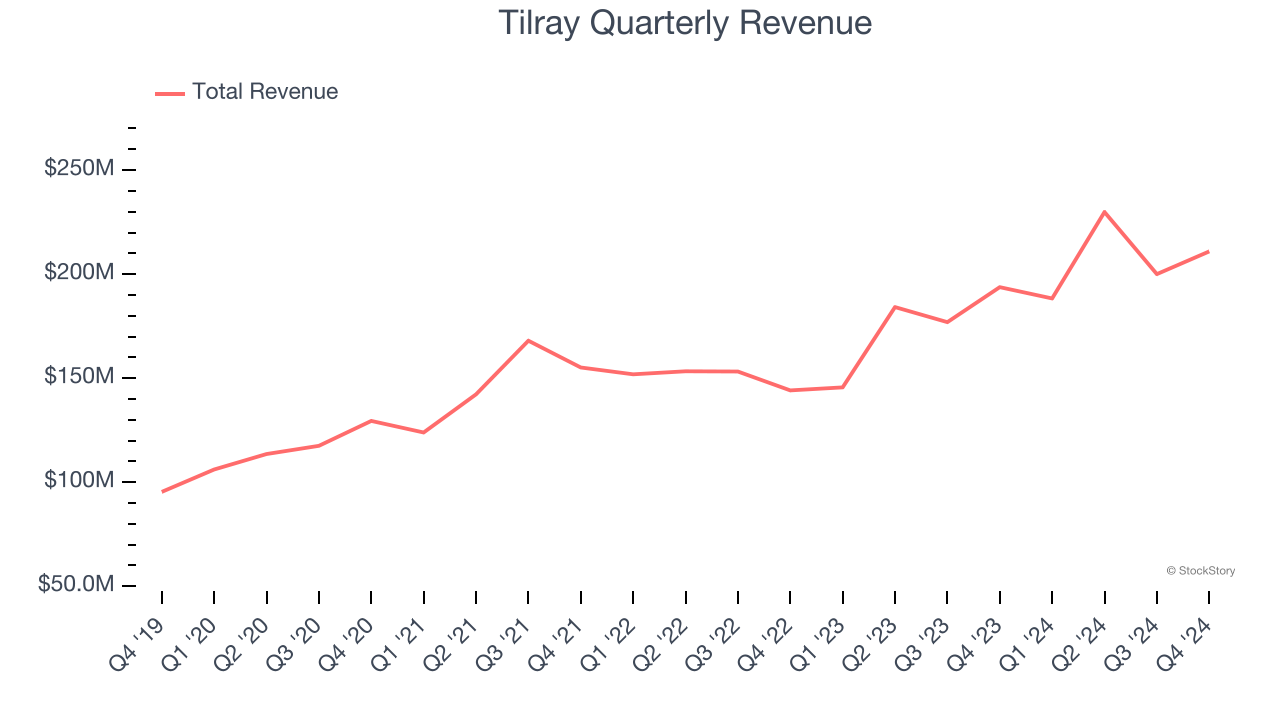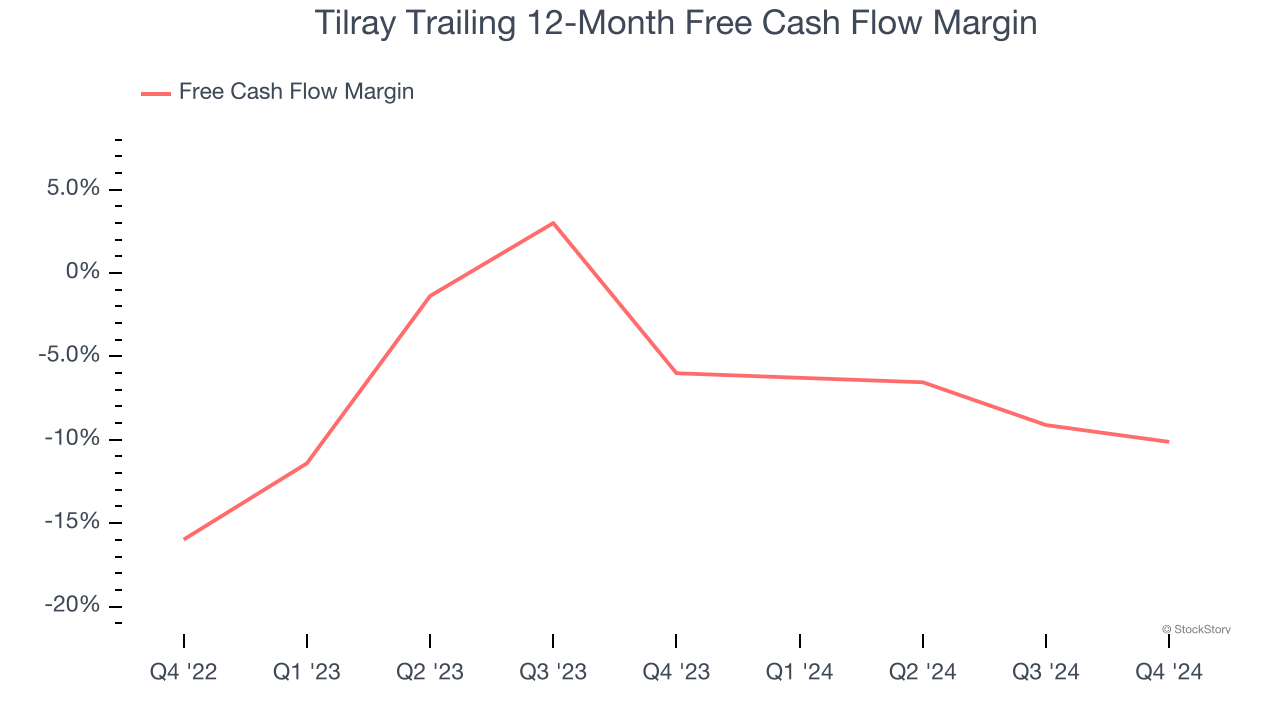Cannabis company Tilray Brands (NASDAQ:TLRY) missed Wall Street’s revenue expectations in Q4 CY2024, but sales rose 8.9% year on year to $211 million. On the other hand, the company’s full-year revenue guidance of $975 million at the midpoint came in 8.2% above analysts’ estimates. Its non-GAAP loss of $0 per share was $0.01 above analysts’ consensus estimates.
Is now the time to buy Tilray? Find out in our full research report.
Tilray (TLRY) Q4 CY2024 Highlights:
- Revenue: $211 million vs analyst estimates of $216.3 million (8.9% year-on-year growth, 2.5% miss)
- Adjusted EPS: $0 vs analyst estimates of -$0.01 ($0.01 beat)
- Adjusted EBITDA: $9.02 million vs analyst estimates of $12.3 million (4.3% margin, 26.7% miss)
- Management’s revenue guidance for the upcoming financial year 2025 is $975 million at the midpoint, beating analyst estimates by 8.2% and implying 17.6% growth (vs 19% in FY2024)
- Operating Margin: -20%, up from -21.6% in the same quarter last year
- Free Cash Flow was -$46.19 million compared to -$36.25 million in the same quarter last year
- Market Capitalization: $1.24 billion
Irwin D. Simon, Chairman and Chief Executive Officer of Tilray Brands, stated, "In our fiscal second quarter, Tilray achieved strong results while making significant progress on our strategic plan. Our dedication to operational excellence has improved Gross Margins, Gross Profit, and overall profitability across our business segments, positioning us favorably for future success."
Company Overview
Founded in 2013, Tilray Brands (NASDAQ:TLRY) engages in in cannabis research, cultivation, and distribution, offering a range of medical and recreational cannabis products, hemp-based foods, and alcoholic beverages.
Beverages, Alcohol, and Tobacco
These companies' performance is influenced by brand strength, marketing strategies, and shifts in consumer preferences. Changing consumption patterns are particularly relevant and can be seen in the rise of cannabis, craft beer, and vaping or the steady decline of soda and cigarettes. Companies that spend on innovation to meet consumers where they are with regards to trends can reap huge demand benefits while those who ignore trends can see stagnant volumes. Finally, with the advent of the social media, the cost of starting a brand from scratch is much lower, meaning that new entrants can chip away at the market shares of established players.
Sales Growth
Reviewing a company’s long-term sales performance reveals insights into its quality. Any business can have short-term success, but a top-tier one grows for years.
Tilray is a small consumer staples company, which sometimes brings disadvantages compared to larger competitors benefiting from economies of scale and negotiating leverage. On the other hand, it can grow faster because it’s working from a smaller revenue base and has a longer runway of untapped store chains to sell into.
As you can see below, Tilray’s sales grew at a solid 12.1% compounded annual growth rate over the last three years. This shows it had good demand, a useful starting point for our analysis.

This quarter, Tilray’s revenue grew by 8.9% year on year to $211 million, missing Wall Street’s estimates.
Looking ahead, sell-side analysts expect revenue to grow 14.4% over the next 12 months, an acceleration versus the last three years. This projection is noteworthy and indicates its newer products will spur better top-line performance.
Today’s young investors won’t have read the timeless lessons in Gorilla Game: Picking Winners In High Technology because it was written more than 20 years ago when Microsoft and Apple were first establishing their supremacy. But if we apply the same principles, then enterprise software stocks leveraging their own generative AI capabilities may well be the Gorillas of the future. So, in that spirit, we are excited to present our Special Free Report on a profitable, fast-growing enterprise software stock that is already riding the automation wave and looking to catch the generative AI next.
Cash Is King
Although earnings are undoubtedly valuable for assessing company performance, we believe cash is king because you can’t use accounting profits to pay the bills.
Tilray’s demanding reinvestments have drained its resources over the last two years, putting it in a pinch and limiting its ability to return capital to investors. Its free cash flow margin averaged negative 8.2%, meaning it lit $8.24 of cash on fire for every $100 in revenue.
Taking a step back, we can see that Tilray’s margin dropped by 4.1 percentage points over the last year. Almost any movement in the wrong direction is undesirable because it is already burning cash. If the trend continues, it could signal it’s becoming a more capital-intensive business.

Tilray burned through $46.19 million of cash in Q4, equivalent to a negative 21.9% margin. The company’s cash burn was similar to its $36.25 million of lost cash in the same quarter last year.
Key Takeaways from Tilray’s Q4 Results
We were impressed by how Tilray beat analysts’ EPS expectations this quarter. We were also glad its full-year revenue guidance came in higher than Wall Street’s estimates. On the other hand, its EBITDA missed significantly and its gross margin fell short of Wall Street’s estimates. Zooming out, we think this was a mixed quarter. The market seemed to focus on the negatives, and the stock traded down 3.3% to $1.33 immediately following the results.
Is Tilray an attractive investment opportunity at the current price? The latest quarter does matter, but not nearly as much as longer-term fundamentals and valuation, when deciding if the stock is a buy. We cover that in our actionable full research report which you can read here, it’s free.
